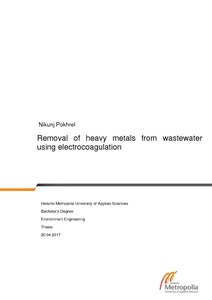Removal of heavy metals from wastewater using electrocoagulation
Pokhrel, Nikunj (2017)
Pokhrel, Nikunj
Metropolia Ammattikorkeakoulu
2017
All rights reserved
Julkaisun pysyvä osoite on
https://urn.fi/URN:NBN:fi:amk-2017052910712
https://urn.fi/URN:NBN:fi:amk-2017052910712
Tiivistelmä
Heavy metal contamination of water sources is a constant threat to human health. High exposure of heavy metals have often resulted in severe health hazards such as cancer, growth deficiency, liver and kidney damage and in some extreme cases death (World Health Organization, 2005). Heavy metals are often released into the environment and mainly into the water sources in the form of industrial and municipal wastewater. This thesis aims at examining the possibility of removing 5 different heavy metals from synthetic wastewater using a fairly new technique; electrocoagulation. It also explores the impact of different parameters involved during the electrocoagulation and establishes the optimum levels for the parameters. The parameters whose effects were chosen for study are initial pH of the solution, current density and initial metal concentration. The thesis was approached by doing a literature review of the heavy metals where the impact and characteristics of the chosen metals are first discussed and an overview of current technologies used to remove heavy metals is provided. The experiments were carried out at the environmental engineering laboratory in the Metropolia University of Applied Sciences, Vantaa. The samples were collected at different time intervals between 10 to 40 minutes of the experiment and the residual metal concentration was analysed using the micro plasma atomic emission spectrophotometry (MP-AES).
The results showed that the best removal is obtained at a very high pH of 9, current density of 6.25 mA/cm2 at the end of 20 minutes for all the metal concentration. The removal rate was found to be significantly dependent on pH of the solution. Higher pH levels resulted in higher removal rate. All the 4 metals showed excellent removal in the majority of the samples apart from manganese. The removal of manganese was found to be most difficult and was only possible at a high pH of 9.
The results showed that the best removal is obtained at a very high pH of 9, current density of 6.25 mA/cm2 at the end of 20 minutes for all the metal concentration. The removal rate was found to be significantly dependent on pH of the solution. Higher pH levels resulted in higher removal rate. All the 4 metals showed excellent removal in the majority of the samples apart from manganese. The removal of manganese was found to be most difficult and was only possible at a high pH of 9.
